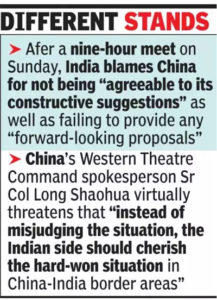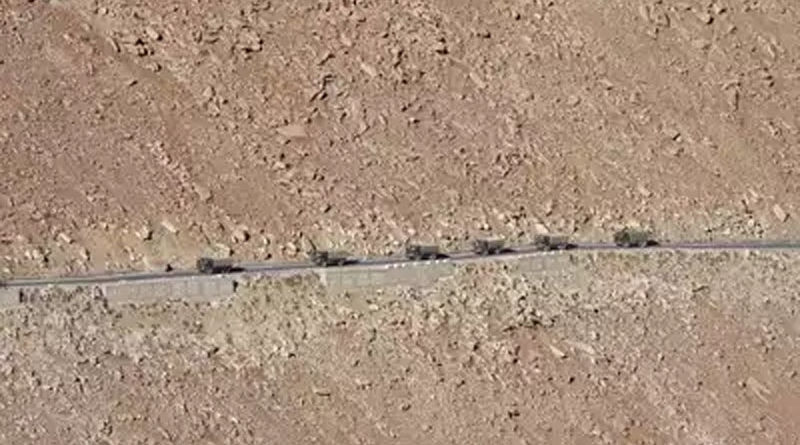India, China Lash Out At Each Other As Talks Reach Bitter Deadlock
Oct 12, 2021
NEW DELHI: The 13th round of top-level military talks between India and China ended in a bitter stalemate on Sunday, with New Delhi blaming Beijing for not being “agreeable to its constructive suggestions” as well as failing to provide any “forward-looking proposals” in defusing the 17-month military confrontation in eastern.
China’s Western Theatre Command spokesperson Senior Colonel Long Shaohua went a step ahead by virtually threatening that “instead of misjudging the situation, the Indian side should cherish the hard-won situation in China-India border areas”.
This hardening of stands by the two sides, in effect, means the around 50,000 troops each deployed on the frontier are headed for a second successive winter in eastern Ladakh, where temperatures dip to minus 30 degree Celsius along with acute oxygen deprivation.

The almost nine-hour meeting on Sunday, led by 14 Corps commander Lt-General P G K Menon and South Xinjiang Military District chief of staff Major General Zhao Zhidan, “failed to move even an inch” towards completing the stalled troop disengagement at Patrolling Point-15 (PP-15) in the Hot Springs-Gogra-Kongka La area, said sources.
“Consequently, the much bigger problems at Charding Ninglung Nallah (CNN) track junction at Demchok and Depsang Plains simply seem insurmountable as of now. Incidentally, there was a new PLA Major General heading the delegation (earlier rounds were led by Major General Liu Lin, who is now a Lt-General) this time,” said a source.
The deadlock in the talks, which came soon after the PLA’s stepped-up incursions in Uttarakhand and Arunachal Pradesh along the 3,488-km Line of Actual Control, led the two sides to issue separate unusually strong statements on Monday morning, unlike the joint ones in the past.
“The Indian side emphasised resolution of the remaining areas would facilitate progress in the bilateral relations. The Indian side, therefore, made constructive suggestions but the Chinese side was not agreeable and also could not provide any forward looking proposals. The meeting thus did not result in resolution of the remaining areas,” said the Indian statement.
The Chinese military spokesperson, in turn, accused the Indian side of “persisting in its unreasonable and unrealistic demands, which added difficulties to the negotiations”.
The PLA statement clearly conveyed its unwillingness to go beyond the disengagement achieved in the Pangong Tso-Kailash Range region in February and at PP-17A near India’s crucial Gogra post in early-August.
This will reinforce concerns that India should not have squandered its major bargaining leverage by agreeing to vacate the Kailash Range heights, which Indian troops had occupied in a daring manoeuvre in end-August last year, in return for justhe Pangong Tso disengagement pact.
Moreover, the no-patrol buffer zones created after disengagement at PP-14 in Galwan Valley, PP-17A near Gogra and Pangong Tso, which vary from 3-km to almost 10-km, have largely come up in what India claims to be its territory.
The Indian statement, however, said the two sides agreed to maintain communications as well as stability on the ground. “It is our expectation that the Chinese side will take into account the overall perspective of bilateral relations and will work towards early resolution of the remaining issues while fully abiding by bilateral agreements and protocols,” it said.
Pointing out that the situation along the LAC had been caused by China’s “unilateral attempts to alter the status quo and in violation of the bilateral agreements”, the statement said it was necessary that China take “appropriate steps” in the remaining areas so as to restore peace and tranquillity.
This would also be in accordance with the “guidance provided” by the two foreign ministers, S Jaishankar and Wang Yi, in their meeting in Dushanbe last month, where they had agreed that the two sides should resolve the remaining issues at the earliest, it added.
Courtesy: TOI

